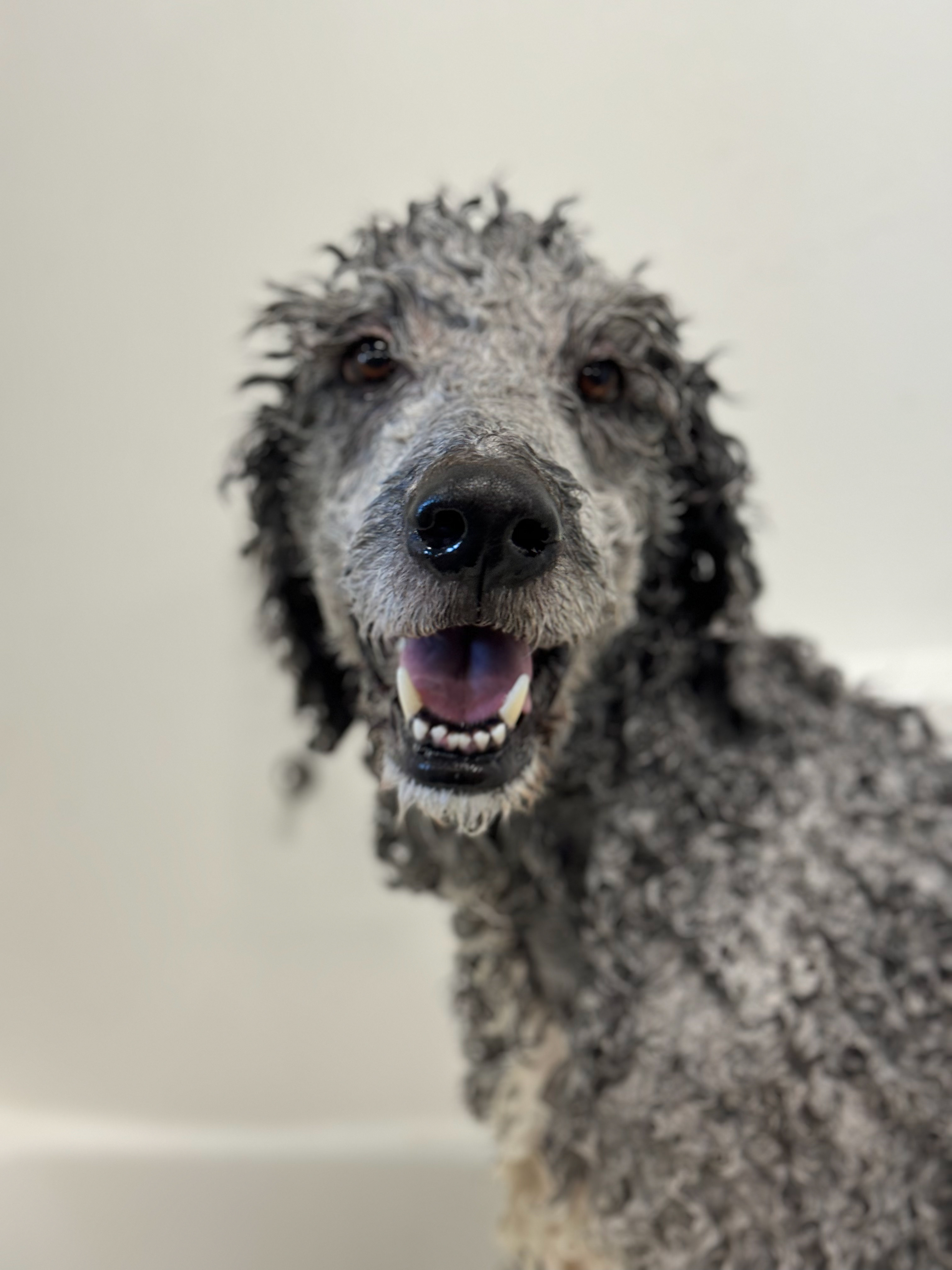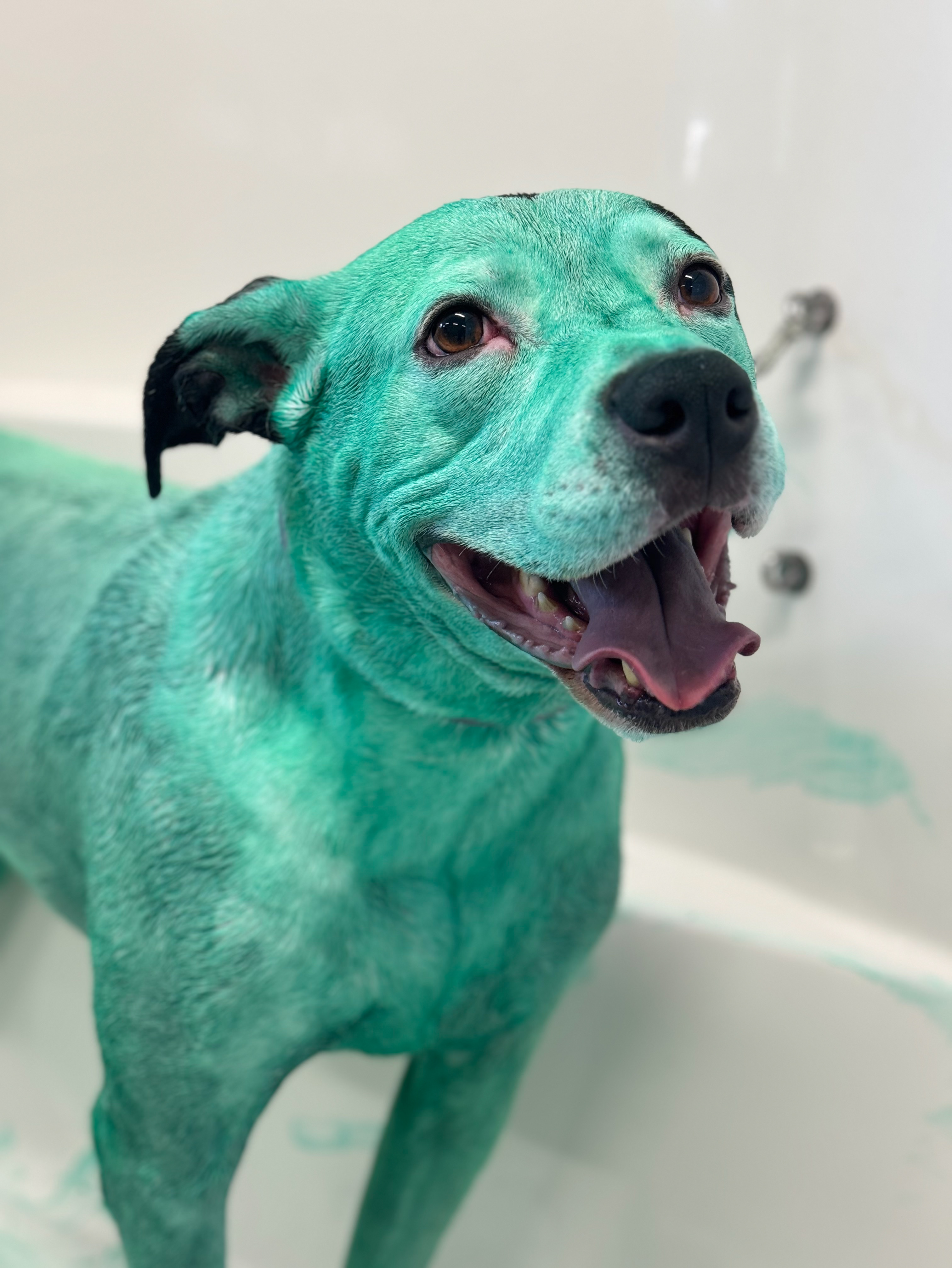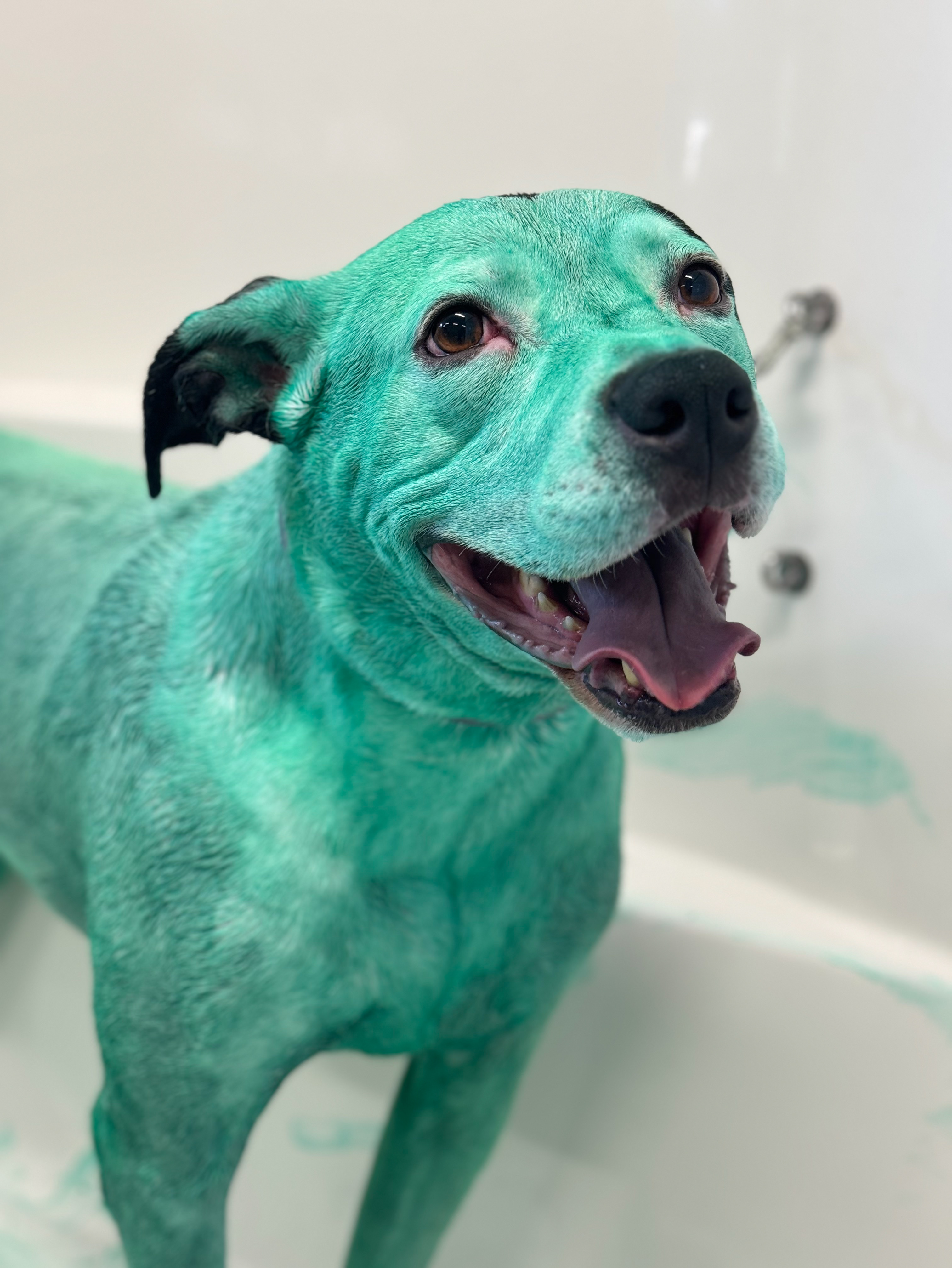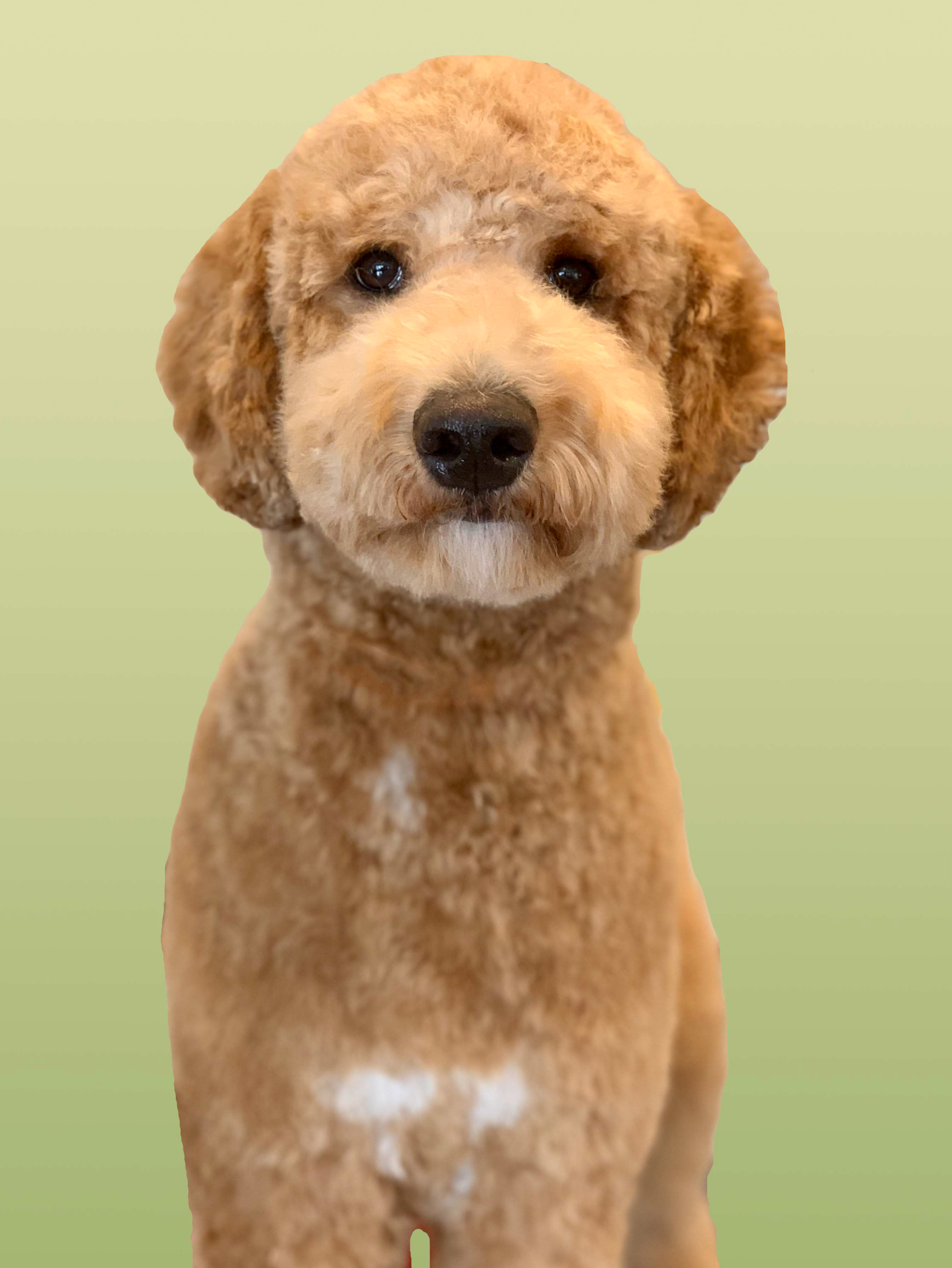Skin & Coat Health in the Warmer Months
By Willow Butowicz, APG
The days are getting longer and the weather is getting warmer. Summer is upon us! With this change in the seasons, you might be wondering how to keep your furry friend comfortable. How do you keep your dog cool? What can groomers do to help support your dog’s health? Let’s take a deep dive into canine skin and coat to learn all about how to keep your dog safe and happy during the sunny season.
STEP ONE: Understanding Canine Skin & Coat
The first thing to recognize is that dogs and humans are very different. For one, dogs have four legs while we only have two, but you may have noticed that already. The biggest difference, however, is how our internal processes work when it comes to thermal regulation.
Compared to other mammals, humans have adapted exceedingly well to heat. Unfortunately for our four legged family members, they did not fare so well. However, they have adapted in a few highly specific ways.
PANTING
Dogs have specialized circulatory systems that allow heat to escape their bodies. They do this by panting. The act of panting evaporates water in their mouths and across the dog’s tongue to cool them off. Furthermore, it causes air to flow over their dog’s wet mucous membranes in their nose. Their nose is shaped especially for this action, and it is also what allows them to smell so well.
Image courtesy of Harpeth Hills Animal Hospital
However, it is important to note that panting can be a sign of a great many things other than feeling toasty. Dogs can pant when they are excited, when they are exercising, when they are nervous, or when they are in pain or discomfort. Reading the rest of a dog’s body language can be helpful in determining the cause of your dog’s panting. If you’d like to learn more about dog body language, check out Doggy Language by Lili Chin.
COAT
A dog’s hair follicles have a special muscle, called the arrector pili muscle, that raises and lowers their hair follicles. Think of when you get ‘goose bumps' and your hair raises up - it is a similar action. The important thing to note here is that, unlike humans, dogs have compound follicles - each of their hair follicles can house up to FIFTEEN hairs! Imagine how strong these muscles have to be to lift up so much coat.
Image courtesy of Metro Mobile Vet
These powerful little muscles raise and lower a dog’s coat to either change (muscles engage and raise the coat) or maintain (muscles relax and lower the coat) the dog’s temperature. By raising the hairs, the arrector pili muscles engage to increase the amount of airflow between each hair and release trapped body heat. By lowering a dog’s coat, the arrector pili muscles engage to decrease the amount of airflow and maintain the dog’s existing temperature.
Disclaimer: While this article is not about the ethics of shaving dogs, there are a few important notes to make about how shaving dogs can affect the arrector pili muscles, and therefore your dog’s health in summer specifically. Here are some things to consider:
Taking the coat too short on any dog can interfere with the dog’s natural thermoregulation abilities by either reducing the effectiveness of the arrector pili muscles, or, if shaved to the skin, risking damaging them – sometimes permanently. This makes the dog more susceptible to heat-related illness. Furthermore, shaving dogs can cause several other health issues. Double coated dogs may get post-clipper alopecia, where the hair cannot grow back due to damage of the muscles and structure of the coat itself by impacting the way the undercoat and top coat interact with each other. Single-coated dogs may have a damaged sebum layer which can cause growths of bumps; this most commonly affects Schnauzers and other terriers. This makes the dogs more susceptible to allergies and wounds. Shaving dogs to the skin in the summer also increases the risk of sunburn, which brings us to the skin section.
SKIN
A dog’s skin does not sweat the way a human’s skin does. Dogs do have glands that release oil all over their body, which is highly important for their overall health. A dog’s sebum layer is thicker than a human’s, and is responsible for everything from wound healing, prevention of allergic reactions, and general skin and coat resilience. However, their “sweat” glands (the glands that secrete hormones and are capable of “cooling” like human sweat can) only exist on their paw pads and in their groin. You may notice an overheated dog leaves “wet” pawprints when it walks; this is why. Dogs also have special cells, called langerhans cells, that are important for their immune function. Unfortunately, these cells are damaged and destroyed by repeat sun exposure. It’s important to either leave enough coat on your dog (at least ⅜”, ideally ¾”) or be stringent in your application of sunscreen to protect these important cells.
Image courtesy of Acupet Wellness
STEP TWO: What You Can Do at Home
Now that we understand how a dog’s body naturally works to cool itself, how can you support your pet as their owner and friend? Let’s take a look at the four main ways you can protect and soothe your furry family this summer.
WATER
Remember how panting cools a dog down by evaporating water? Well, you can help this process by giving your dog plenty of cool or chilled water to drink. You can keep some ice cubes in your dog’s water bowl and let them slowly melt throughout the day, or even give them “pupsicles” made from low sodium broth or frozen fruit if they’re not exhibiting signs of stress.
Image courtesy of The Almond Eater
Splash your dog’s feet and belly/groin with cool (never cold/freezing) water. Let your dog wade in your bathtub, a kiddie pool, or even take them swimming. It’s important to not rub your dog’s skin with ice or douse them in ice water, as this can cause too much of a shock to your dog’s system and be dangerous, just like with humans suffering from heat-related illness. It’s best to use water that is slightly cool to the touch.
AIRFLOW
Unfortunately, setting up a simple fan will not help a dog, but a swamp cooler or air conditioner will. Since dogs do not sweat on their body like humans do, the function of a fan is of little use to them - they have no sweat to evaporate! However, if you are able to use an air conditioner or even a swamp cooler, the cold air will indeed help. Refer back to the section on “panting” to learn more.
BRUSHING
Keeping your dog thoroughly brushed out during the warmer months will help ensure the arrector pili muscles can work properly. By removing the dead coat, you are freeing up space for the hair to move and reducing the weight the muscles have to pull in order to lift and lower the coat. Try adding in five minutes of brushing to your pet’s daily routine; you can pair it with an existing routine to make it easier to add into your schedule, like doing it right after you brush your teeth or right before you take them for a walk. Make it fun by filling a kong with peanut butter, or giving them some high value treats. Brushing can become a fun bonding experience for you and your pet to share. As a bonus, regular brushing means you won’t be pulling on tangles and will be easier on your pet’s skin.
Image courtesy of The Spruce Pets
SUN PROTECTION
To prevent sunburn, make sure your dog has ample access to shade. If they have either no hair or short hair, use a dog-safe sunscreen or dress them in sun-protective clothing (Warren London, Lucky Pup, and Handy Hound all make good dog sunscreens; Hurtta is a good brand for protective clothing). Every dog has a different tolerance for being out in direct sun; brachycephalic (flat-faced, like a Pug) breeds have more trouble cooling themselves down, as do large breed dogs. Talk to your vet to find out what is safe for your individual pet.
Related to heat protection in general, make sure to keep an eye on your dog’s paws! In 80 degree weather, asphalt can be 115 degrees or higher. Make sure to put heat protectant balm or booties on your dog’s feet. And of course, NEVER leave your dog unattended in a vehicle in hot weather. It only takes 10 minutes for a car to go from 75 degrees to 100 degrees.
Image courtesy of The Spruce Pets
STEP THREE: Where the Groomer Comes In
Now that you know what you can do at home, let’s look at what the professionals can do to help make your life easier. Going into this you may have first thought that removing as much coat as possible is the best way to help your dog, but as we’ve learned above, removing the dog’s entire coat is, at best, ineffective and is, at worst, harmful for your dog. So how can we help you?
BATHING & BRUSHING
Through the bathing, drying, and brushing process, groomers can remove as much “dead” coat as possible, helping your dog regulate its body temperature more effectively. Helping the coat that is in its catagen (where the coat releases from the follicle) and exogen stages (when the coat is shedding out entirely) be removed from the dog’s body helps the arrector pili muscles function more efficiently.
Image courtesy of Temple of the Dog
GROOMING
In terms of heat regulation specifically, the most important things to do are shaving the paw pads and the belly. Dogs can have hair removed where they need it most so they can sweat more effectively, without being damaged by the sun. Any mats can also be taken out to further enhance the dog’s thermoregulation abilities.
You may be thinking, “that’s all well and good, but I take my dog out on more adventures in the summer! He’s going to get so dirty! Stuff will get stuck in his coat!”
I hear you! I'm an active adventurer myself. Remember, dogs that are shaved are at higher risk for heat-related illness and sunburn. Furthermore, all of that coat is protection for your dog! It’s better that stuff gets stuck in their coat where it can be brushed or cut out than stuck in their skin where it can cause abrasions or punctures. The denser a dog’s natural coat is, the thinner their skin is, and the more susceptible they are to tears and abrasions.
If you’d like a shorter cut to help with maintenance, I recommend a very heavy profile trim for double coated dogs or 1/2” length for single coated dogs. For double coated dogs, this gets rid of their “feathering” on the underside, chest, legs, and haunches. This enables them to still have the important thermoregulation capabilities their body requires while removing lots of excess, long coat that can tangle and mat.
Example courtesy of Apryl’s Animal House
For single coated dogs, the ½” length removes enough of their hair that your maintenance at home will be easier while also ensuring that they are protected from the sun.
Image and haircut by Willow Butowicz, APG
If you are in love with your dog’s short haircut, I may still take your dog short if you’d like! Sometimes, this is even necessary; especially for older, arthritic pets or for dogs that are matted. However, know that shaving your dog will, unfortunately, not cool him down, and that you may need to apply sunscreen and keep an extra eye on him for heat-related illness.
FINAL THOUGHTS
I hope this guide helps you understand how to keep your furry friend safe and comfortable this coming warm season. As a professional dog lover, I am committed to keeping your dog safe and happy, and also making sure you are getting a haircut that works for your lifestyle. Feel free to call me with any questions that may arise. Thank you for being committed to being the best owner you can be for your pet! I look forward to seeing you.
For a list of recommended products, see the following link for shopping suggestions. Make sure to check your local pet stores like Mud Bay or Pet Stop before buying online.
SOURCES
International Certified Advanced Professional Groomer Handbook, by Linda Easton
Hair & Skin 101 Certificate Course, by Dr. Cliff Faver
AKC Website: Do Dogs Need Sunscreen?
ABOUT THE AUTHOR
Willow Butowicz, APG, is an IPG-certified Advanced Professional Groomer. She has been working in the pet styling industry since 2012 and attended Grooming Academy in 2015. She is trained in Pet First Aid & CPR and she has completed Dr. Cliff Faver’s Hair & Skin 101 Certificate Course.











